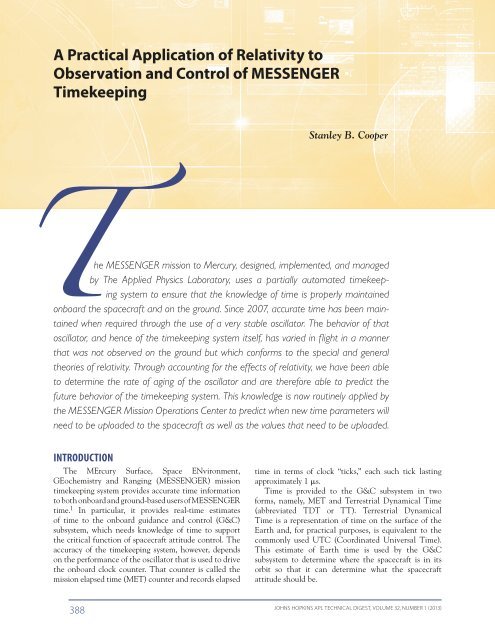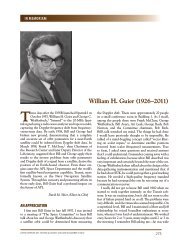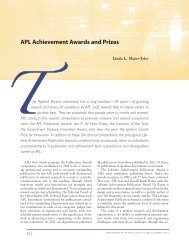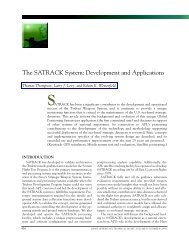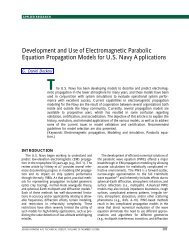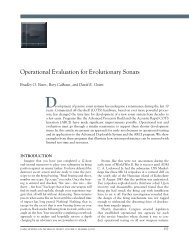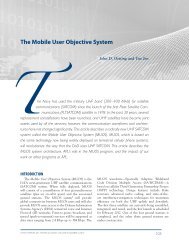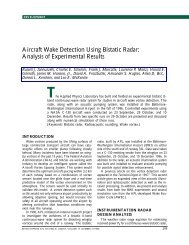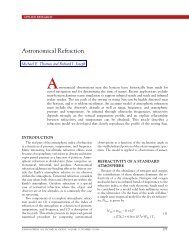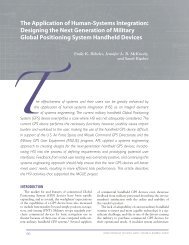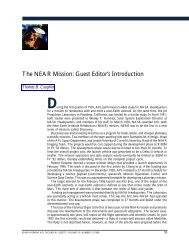A Practical Application of Relativity to Observation and Control of ...
A Practical Application of Relativity to Observation and Control of ...
A Practical Application of Relativity to Observation and Control of ...
Create successful ePaper yourself
Turn your PDF publications into a flip-book with our unique Google optimized e-Paper software.
A <strong>Practical</strong> <strong>Application</strong> <strong>of</strong> <strong>Relativity</strong> <strong>to</strong><br />
<strong>Observation</strong> <strong>and</strong> <strong>Control</strong> <strong>of</strong> MESSENGER<br />
Timekeeping<br />
INTRODUCTION<br />
The MErcury Surface, Space ENvironment,<br />
GEochemistry <strong>and</strong> Ranging (MESSENGER) mission<br />
timekeeping system provides accurate time information<br />
<strong>to</strong> both onboard <strong>and</strong> ground-based users <strong>of</strong> MESSENGER<br />
time. 1 In particular, it provides real-time estimates<br />
<strong>of</strong> time <strong>to</strong> the onboard guidance <strong>and</strong> control (G&C)<br />
subsystem, which needs knowledge <strong>of</strong> time <strong>to</strong> support<br />
the critical function <strong>of</strong> spacecraft attitude control. The<br />
accuracy <strong>of</strong> the timekeeping system, however, depends<br />
on the performance <strong>of</strong> the oscilla<strong>to</strong>r that is used <strong>to</strong> drive<br />
the onboard clock counter. That counter is called the<br />
mission elapsed time (MET) counter <strong>and</strong> records elapsed<br />
388<br />
Stanley B. Cooper<br />
he MESSENGER mission <strong>to</strong> Mercury, designed, implemented, <strong>and</strong> managed<br />
by The Applied Physics Labora<strong>to</strong>ry, uses a partially au<strong>to</strong>mated timekeeping<br />
system <strong>to</strong> ensure that the knowledge <strong>of</strong> time is properly maintained<br />
onboard the spacecraft <strong>and</strong> on the ground. Since 2007, accurate time has been maintained<br />
when required through the use <strong>of</strong> a very stable oscilla<strong>to</strong>r. The behavior <strong>of</strong> that<br />
oscilla<strong>to</strong>r, <strong>and</strong> hence <strong>of</strong> the timekeeping system itself, has varied in flight in a manner<br />
that was not observed on the ground but which conforms <strong>to</strong> the special <strong>and</strong> general<br />
theories <strong>of</strong> relativity. Through accounting for the effects <strong>of</strong> relativity, we have been able<br />
<strong>to</strong> determine the rate <strong>of</strong> aging <strong>of</strong> the oscilla<strong>to</strong>r <strong>and</strong> are therefore able <strong>to</strong> predict the<br />
future behavior <strong>of</strong> the timekeeping system. This knowledge is now routinely applied by<br />
the MESSENGER Mission Operations Center <strong>to</strong> predict when new time parameters will<br />
need <strong>to</strong> be uploaded <strong>to</strong> the spacecraft as well as the values that need <strong>to</strong> be uploaded.<br />
time in terms <strong>of</strong> clock “ticks,” each such tick lasting<br />
approximately 1 ms.<br />
Time is provided <strong>to</strong> the G&C subsystem in two<br />
forms, namely, MET <strong>and</strong> Terrestrial Dynamical Time<br />
(abbreviated TDT or TT). Terrestrial Dynamical<br />
Time is a representation <strong>of</strong> time on the surface <strong>of</strong> the<br />
Earth <strong>and</strong>, for practical purposes, is equivalent <strong>to</strong> the<br />
commonly used UTC (Coordinated Universal Time).<br />
This estimate <strong>of</strong> Earth time is used by the G&C<br />
subsystem <strong>to</strong> determine where the spacecraft is in its<br />
orbit so that it can determine what the spacecraft<br />
attitude should be.<br />
JOHNS HOPKINS APL TECHNICAL DIGEST, VOLUME 32, NUMBER 1 (2013)
The spacecraft actually contains four oscilla<strong>to</strong>rs that<br />
can be used <strong>to</strong> support onboard timekeeping. The current<br />
configuration <strong>of</strong> the spacecraft avionics allows either<br />
<strong>of</strong> two <strong>of</strong> those oscilla<strong>to</strong>rs <strong>to</strong> be used <strong>to</strong> drive the MET<br />
counter. One is a very stable oven-controlled crystal<br />
oscilla<strong>to</strong>r (OCXO) that is used <strong>to</strong> provide the timekeeping<br />
system accuracy required <strong>to</strong> support science observations.<br />
Owing <strong>to</strong> reliability concerns, however, the other<br />
less-stable “coarse” oscilla<strong>to</strong>r is used <strong>to</strong> drive the MET<br />
counter whenever an engine burn is performed. This has<br />
occurred numerous times—during cruise, during Mercury<br />
orbit insertion (MOI), <strong>and</strong> also at many solar perihelia<br />
<strong>and</strong> aphelia while the spacecraft is in orbit around<br />
Mercury. This occasional deselection <strong>of</strong> the “precision”<br />
oscilla<strong>to</strong>r, the OCXO, has produced numerous gaps in<br />
our record <strong>of</strong> OCXO performance. Even with those<br />
gaps, however, some very interesting <strong>and</strong> useful information<br />
has been gathered about the behavior <strong>of</strong> the OCXO<br />
<strong>and</strong> <strong>of</strong> the timekeeping system itself.<br />
The timekeeping system produces, on the ground,<br />
an estimate <strong>of</strong> the correlation between MET <strong>and</strong> Earth<br />
time in terms <strong>of</strong> the TT system. It saves that estimate<br />
in a text file called the Operations SCLK (Spacecraft<br />
Clock) Kernel. The SCLK Kernel estimate <strong>of</strong> clock<br />
behavior directly maps <strong>to</strong> average oscilla<strong>to</strong>r behavior.<br />
When the OCXO is selected, comparison <strong>of</strong> that average<br />
oscilla<strong>to</strong>r behavior <strong>to</strong> how we would predict the<br />
oscilla<strong>to</strong>r <strong>to</strong> behave according <strong>to</strong> the special <strong>and</strong> general<br />
theories <strong>of</strong> relativity provides us with knowledge <strong>of</strong> how<br />
much the OCXO behavior deviates from those predictions.<br />
Those “residuals” tell us how the physical OCXO<br />
actually behaves, as a local observer on the spacecraft<br />
would see it. Trending those residuals allows us <strong>to</strong> predict<br />
how the OCXO will behave in the future, <strong>and</strong> that<br />
prediction, in turn, is routinely used by the MESSEN-<br />
GER Mission Operations Center at APL <strong>to</strong> control the<br />
onboard real-time estimate<br />
<strong>of</strong> Earth time (TT) used by<br />
the G&C subsystem. 2<br />
The MESSENGER timekeeping<br />
system has not<br />
only provided us with the<br />
practical result <strong>of</strong> accurate<br />
onboard time for the G&C<br />
subsystem but has also provided<br />
a rare opportunity<br />
<strong>to</strong> have a glimpse, however<br />
small, in<strong>to</strong> the theoretical<br />
universe <strong>of</strong> Albert Einstein.<br />
THE VENUS FLYBY IN 2007<br />
In early 2007, the MES-<br />
SENGER spacecraft began<br />
<strong>to</strong> use the oscilla<strong>to</strong>r designated<br />
OCXO-B <strong>to</strong> control<br />
the spacecraft clock. Shortly<br />
Frequency <strong>of</strong>fset (clock drift rate) (ppb)<br />
35<br />
30<br />
25<br />
20<br />
15<br />
10<br />
5<br />
Actual MET drift rate<br />
Residual clock drift rate<br />
MET drift rate minus velocity effect<br />
afterward, the spacecraft had its second flyby <strong>of</strong> Venus<br />
<strong>to</strong> provide a gravity-assisted course correction on its<br />
long journey <strong>to</strong>ward Mercury. The variation in OCXO<br />
behavior that was evident from the behavior <strong>of</strong> the MET<br />
counter as estimated in the Operations SCLK Kernel<br />
was much greater than we had seen during testing on<br />
the Earth <strong>and</strong> was much greater than could be explained<br />
by environmental fac<strong>to</strong>rs such as the sensitivity <strong>of</strong> the<br />
OCXO output frequency <strong>to</strong> temperature variations. The<br />
explanation lies in the theory <strong>of</strong> relativity, which tells us<br />
that both velocity <strong>and</strong> gravity can measurably affect the<br />
observed behavior <strong>of</strong> a distant clock or oscilla<strong>to</strong>r. Time,<br />
according <strong>to</strong> the theory, is not the same for all observers.<br />
<strong>Observation</strong>s during the 2 months after the OCXO<br />
was selected, including the closest approach <strong>to</strong> Venus<br />
during the second MESSENGER flyby <strong>of</strong> Venus, are<br />
illustrated in Fig. 1. The observed OCXO fractional<br />
frequency <strong>of</strong>fset (bot<strong>to</strong>m curve) varied by 11 parts per<br />
billion (ppb), much more than we had observed during<br />
ground testing. That is equivalent <strong>to</strong> a variation in the<br />
MET counter <strong>of</strong> 11 ns/s or 0.95 ms/day. This OCXO was<br />
cus<strong>to</strong>m designed <strong>to</strong> limit sensitivity <strong>to</strong> environmental<br />
fac<strong>to</strong>rs <strong>and</strong>, for example, was designed <strong>to</strong> allow only<br />
4 ppb OCXO fractional frequency variation or 0.35 ms/<br />
day over the full 40°C operational temperature range.<br />
Also, the oscilla<strong>to</strong>r experienced a temperature variation<br />
<strong>of</strong> only 4°C during the Venus flyby. The frequency<br />
changes that we observed were much greater than environmental<br />
variations could cause.<br />
Let’s focus first on the effect <strong>of</strong> velocity on the oscilla<strong>to</strong>r<br />
frequency performance. Special relativity tells us that<br />
time on the spacecraft (the MET counter) is related <strong>to</strong> the<br />
time perceived by a distant observer by the Lorentz fac<strong>to</strong>r<br />
= 1/ [1 − (v 2 /c 2 )] 0.5 , where c is the speed <strong>of</strong> light <strong>and</strong> v<br />
is the magnitude <strong>of</strong> the velocity <strong>of</strong> the spacecraft in the<br />
coordinate frame <strong>of</strong> the distant observer. Because oscil-<br />
0 960 970 980 990 1000 1010 1020 1030 1040 1050<br />
Days since launch<br />
Figure 1. Residual MESSENGER OCXO-B behavior after March 2007 turn-on.<br />
JOHNS HOPKINS APL TECHNICAL DIGEST, VOLUME 32, NUMBER 1 (2013) 389
S. B. COOPER<br />
la<strong>to</strong>r frequency <strong>and</strong> clock<br />
time are closely related, the<br />
Lorentz fac<strong>to</strong>r also describes<br />
how our observation <strong>of</strong><br />
OCXO frequency is related<br />
<strong>to</strong> the oscilla<strong>to</strong>r frequency<br />
that would be seen by an<br />
observer traveling with<br />
the spacecraft. Subtracting<br />
this effect from our data,<br />
the bot<strong>to</strong>m curve in Fig. 1,<br />
leads <strong>to</strong> the middle curve.<br />
All computations are with<br />
respect <strong>to</strong> the solar barycenter,<br />
that is, the velocity is<br />
the velocity <strong>of</strong> the spacecraft<br />
according <strong>to</strong> an observer at<br />
the solar barycenter.<br />
A particularly interesting<br />
feature <strong>of</strong> these curves<br />
is that the jump in OCXO<br />
fractional frequency <strong>of</strong>fset that appears near the end<br />
<strong>of</strong> the observed data is absent from those data after<br />
removal <strong>of</strong> the relativistic velocity effect. That jump<br />
corresponds <strong>to</strong> the simultaneous reduction in velocity,<br />
shown in Fig. 2, which resulted from the close flyby <strong>of</strong><br />
Venus. (The apparent time shift in the observed jump in<br />
OCXO frequency compared with the time <strong>of</strong> the jump<br />
in velocity is an artifact <strong>of</strong> the way the frequency jump<br />
was computed, but that detail is discussed later.)<br />
The general theory <strong>of</strong> relativity provides the <strong>to</strong>ols for<br />
underst<strong>and</strong>ing how gravity affects the output frequency<br />
<strong>of</strong> the OCXO. The stronger the gravity field experienced<br />
by the oscilla<strong>to</strong>r, the slower that oscilla<strong>to</strong>r runs, at least<br />
as seen by a distant observer in a fixed gravity field. That<br />
behavior is described by<br />
the expression −(GM/c 2 )/R,<br />
where G is the gravitational<br />
constant, M is the mass <strong>of</strong><br />
the body that is the source<br />
<strong>of</strong> the gravity, c is again the<br />
speed <strong>of</strong> light, <strong>and</strong> R is the<br />
distance from that same<br />
body. For Fig. 1, M is the<br />
mass <strong>of</strong> the Sun, <strong>and</strong> R is the<br />
distance <strong>of</strong> the spacecraft<br />
from the Sun. The gravitational<br />
effect <strong>of</strong> Venus was<br />
also examined but found <strong>to</strong><br />
be negligible on the scale<br />
shown in the figure. The<br />
residual OCXO drift rate<br />
shown, the <strong>to</strong>p curve in<br />
Fig. 1, is the result <strong>of</strong> subtracting<br />
both the gravitational<br />
effect <strong>and</strong> the velocity<br />
390<br />
Frequency <strong>of</strong>fset (clock drift rate) (ppb)<br />
35<br />
30<br />
25<br />
20<br />
15<br />
10<br />
5<br />
Actual MET drift rate<br />
MET drift rate minus velocity effect<br />
Spacecraft velocity<br />
0<br />
0<br />
960 970 980 990 1000 1010 1020 1030 1040 1050<br />
Days since launch<br />
Figure 2. MESSENGER OCXO-B behavior after March 2007 turn-on, with relativistic velocity effect<br />
removed.<br />
Fractional frequency <strong>of</strong>fset (clock drift rate) (ppb)<br />
15<br />
10<br />
5<br />
0<br />
–5<br />
–10<br />
–15<br />
–20<br />
effect from the observed data. The variation <strong>of</strong> residual<br />
frequency <strong>of</strong>fset from 31.0 ppb <strong>to</strong> 30.4 ppb over 70 days<br />
is reasonable <strong>and</strong> can be explained by a combination <strong>of</strong><br />
temperature effects <strong>and</strong> oscilla<strong>to</strong>r frequency aging.<br />
This tells us that, after removal <strong>of</strong> the relativistic<br />
effects, the OCXO was running fast by approximately<br />
30–31 ppb, approximately 2.6–2.7 ms/day.<br />
TDTRATE AND THE MERCURY FLYBYS<br />
After the 2007 flyby <strong>of</strong> Venus, the MESSENGER<br />
spacecraft flew past Mercury three times <strong>and</strong> then, in<br />
a fourth encounter, went in<strong>to</strong> orbit around Mercury.<br />
From the Venus flyby, we were able <strong>to</strong> infer from the<br />
Estimated OCXO-B frequency<br />
<strong>of</strong>fset with relativistic effects<br />
Estimated TDTRATE with<br />
relativistic effects<br />
–25<br />
0.99999998500<br />
1220 1240 1260 1280 1300 1320 1340 1360<br />
Days since launch<br />
JOHNS HOPKINS APL TECHNICAL DIGEST, VOLUME 32, NUMBER 1 (2013)<br />
50<br />
45<br />
40<br />
35<br />
30<br />
25<br />
20<br />
15<br />
10<br />
5<br />
1.00000002500<br />
1.00000002000<br />
1.00000001500<br />
1.00000001000<br />
1.00000000500<br />
1.00000000000<br />
0.99999999500<br />
0.99999999000<br />
Figure 3. Estimated MESSENGER OCXO-B fractional frequency <strong>of</strong>fset <strong>and</strong> TDTRATE during M1 due<br />
<strong>to</strong> relativity, assuming +31 ppb <strong>of</strong>fset without relativity.<br />
Spacecraft velocity (km/s)<br />
TDTRATE (s/s)
ehavior <strong>of</strong> the MET counter<br />
how the OCXO behaved. We<br />
also determined that, with<br />
relativistic effects removed,<br />
the OCXO was running fast,<br />
that is, the OCXO output frequency<br />
was higher than the<br />
nominal design frequency.<br />
Prior <strong>to</strong> the first encounter<br />
with Mercury (M1), we<br />
reversed that process <strong>and</strong>,<br />
with the assumption that the<br />
OCXO was still running fast<br />
by the amount determined<br />
from the Venus data, derived<br />
the expected behavior <strong>of</strong><br />
the OCXO <strong>and</strong> <strong>of</strong> the MET<br />
counter. That result is shown<br />
in Fig. 3, calculated using<br />
spacecraft velocity relative <strong>to</strong><br />
the Sun <strong>and</strong> the gravitational effects <strong>of</strong> both the Sun<br />
<strong>and</strong> Mercury. One curve is the OCXO output frequency<br />
<strong>and</strong> equivalent clock drift rate expressed in parts per<br />
billion. Note how the oscilla<strong>to</strong>r <strong>and</strong> clock slowed down<br />
as solar perihelion was approached. The other curve<br />
expresses the clock behavior in terms <strong>of</strong> the parameter<br />
TDTRATE, an important metric <strong>of</strong> interest <strong>to</strong> Mission<br />
Operations Center staff. Note that the observations <strong>of</strong><br />
clock behavior during the 2007 Venus flyby were actually<br />
observations <strong>of</strong> TDTRATE that were converted<br />
<strong>to</strong> the equivalent oscilla<strong>to</strong>r frequency <strong>of</strong>fset behavior<br />
shown in Figs. 1 <strong>and</strong> 2.<br />
TDTRATE is obtained from the Operations SCLK<br />
Kernel. The Jet Propulsion Labora<strong>to</strong>ry’s Navigation <strong>and</strong><br />
Ancillary Information Facility (NAIF) provides <strong>to</strong> APL<br />
<strong>and</strong> <strong>to</strong> other users a suite <strong>of</strong><br />
s<strong>of</strong>tware <strong>and</strong> information<br />
system <strong>to</strong>ols called Spacecraft<br />
Planet Instruments C-matrix<br />
Events (SPICE), designed <strong>to</strong><br />
provide access <strong>to</strong> information<br />
about space missions.<br />
One component <strong>of</strong> SPICE is<br />
a set <strong>of</strong> “kernels” or parameter<br />
files that contain information<br />
relative <strong>to</strong> specific missions<br />
or <strong>to</strong> space missions in general.<br />
For example, ephemerides<br />
kernels might provide<br />
the ephemerides <strong>of</strong> planets<br />
or <strong>of</strong> specific spacecraft. One<br />
type <strong>of</strong> SPICE kernel is the<br />
SCLK kernel, a text file that<br />
provides mappings between<br />
MET <strong>and</strong> Earth time. Each<br />
time record <strong>of</strong> the SPICE<br />
TDTRATE (s/s)<br />
1.00000003000<br />
1.00000002500<br />
1.00000002000<br />
1.00000001500<br />
1.00000001000<br />
1.00000000500<br />
1.00000000000<br />
0.99999999500<br />
0.99999999000<br />
AN APPLICATION OF RELATIVITY TO SPACE MISSION TIMEKEEPING<br />
Estimated TDTRATE with<br />
relativistic effects<br />
Measured interpolated<br />
TDTRATE<br />
0.99999998500<br />
1220 1240 1260 1280 1300 1320 1340 1360<br />
Days since launch<br />
Figure 4. Estimated MESSENGER OCXO-B TDTRATE during M1 due <strong>to</strong> relativity, assuming<br />
+31 ppb OCXO fractional frequency <strong>of</strong>fset without relativity, compared with actual TDTRATE.<br />
TDTRATE (s/s)<br />
1.00000003000<br />
1.00000002500<br />
1.00000002000<br />
1.00000001500<br />
1.00000001000<br />
1.00000000500<br />
1.00000000000<br />
0.99999999500<br />
0.99999999000<br />
0.99999998500<br />
0.99999998000<br />
SCLK kernel contains three fields: (1) a field equivalent<br />
<strong>to</strong> MET, (2) a field representing Earth time, <strong>and</strong> (3)<br />
a clock change rate. At APL, our SCLK kernels have<br />
always expressed Earth time in the TT time system (previously<br />
abbreviated TDT), <strong>and</strong> we have typically called<br />
the clock change rate TDTRATE.<br />
The st<strong>and</strong>ard JPL SPICE SCLK kernel defines the<br />
clock change rate as a rate <strong>to</strong> be used <strong>to</strong> extrapolate the<br />
current MET–TT mapping <strong>to</strong> future times. At APL, we<br />
describe that rate as a “predicted TDTRATE.” Predicted<br />
TDTRATE is used, for example, in predicting the future<br />
time <strong>of</strong> execution <strong>of</strong> a comm<strong>and</strong> <strong>and</strong> is used <strong>to</strong> provide<br />
real-time estimates <strong>of</strong> time <strong>to</strong> the G&C subsystem.<br />
However, the APL-defined Operations SCLK Kernel<br />
takes that a step further <strong>and</strong> recalculates TDTRATE<br />
V2 is second Venus yby<br />
M1 is rst Mercury yby<br />
M2 is second Mercury yby<br />
M3 is third Mercury yby<br />
MOI is Mercury orbit insertion<br />
Estimated TDTRATE with relativistic effects<br />
Measured TDTRATE<br />
0 500 1000 1500 2000 2500 3000<br />
Days since launch<br />
JOHNS HOPKINS APL TECHNICAL DIGEST, VOLUME 32, NUMBER 1 (2013) 391<br />
V2<br />
M1<br />
M2<br />
M3 MOI<br />
Figure 5. Estimated MESSENGER OCXO-B TDTRATE, including the effects <strong>of</strong> relativity, assuming<br />
+28 ppb OCXO fractional frequency <strong>of</strong>fset without relativity, using orbit determination solution<br />
OD153.
S. B. COOPER<br />
for past times <strong>to</strong> provide<br />
a more accurate mapping<br />
between MET <strong>and</strong> TT. That<br />
improved mapping is needed<br />
<strong>to</strong> provide the time accuracy<br />
required for analysis <strong>of</strong><br />
science observations. That<br />
interpolated TDTRATE is<br />
shown in Fig. 3. The interpolated<br />
TDTRATE is based on<br />
both the current time record<br />
in the SCLK kernel <strong>and</strong> on<br />
the next time record, so the<br />
computed TDTRATE <strong>and</strong><br />
derived oscilla<strong>to</strong>r frequency<br />
“lead” the actual performance<br />
<strong>of</strong> the oscilla<strong>to</strong>r. That<br />
is why the change in oscilla<strong>to</strong>r<br />
frequency shown in Fig. 2<br />
appears <strong>to</strong> occur slightly<br />
before the actual change in spacecraft velocity during<br />
the Venus flyby.<br />
A comparison between the interpolated TDTRATE<br />
taken from the Operations SCLK Kernel after the M1<br />
flyby <strong>and</strong> the relativistic prediction <strong>of</strong> TDTRATE given<br />
in Fig. 3 is shown in Fig. 4. The comparison is fairly good<br />
but not perfect <strong>and</strong> suggested that the +31 ppb OCXO<br />
fractional frequency <strong>of</strong>fset <strong>of</strong> the Venus flyby might need<br />
<strong>to</strong> be adjusted.<br />
Analysis <strong>of</strong> TDTRATE following the second flyby <strong>of</strong><br />
Mercury (M2) provided a better fit <strong>of</strong> +28 ppb <strong>to</strong> the<br />
M1 <strong>and</strong> M2 data, after relativistic effects were removed.<br />
However, that same analysis did not provide a good fit<br />
<strong>to</strong> the Venus flyby data, as can be seen in Fig. 5. The<br />
results shown in this figure provided the first prediction<br />
<strong>of</strong> OCXO TDTRATE through the end <strong>of</strong> the primary<br />
orbital phase <strong>of</strong> the mission, following a full Earth year<br />
in orbit around Mercury, <strong>and</strong> was<br />
calculated using spacecraft velocity<br />
relative <strong>to</strong> the Sun <strong>and</strong> the<br />
gravitational effects <strong>of</strong> the Sun,<br />
Earth, Venus, <strong>and</strong> Mercury. The<br />
gravitational effect <strong>of</strong> distant Jupiter<br />
is insignificant at this scale.<br />
This figure was created using an<br />
orbit determination designated<br />
OD153 by our Navigation Team<br />
at KinetX, as noted in the figure;<br />
later orbit determinations were<br />
used for the later figures. Note<br />
that TDTRATE has local maxima<br />
at solar perihelia, indicating that<br />
the OCXO output frequency <strong>and</strong><br />
the clock drift rate have local<br />
minima near perihelia. Similarly,<br />
TDTRATE has local minima at<br />
392<br />
TDTRATE (s/s)<br />
1.00000003000<br />
1.00000002500<br />
1.00000002000<br />
1.00000001500<br />
1.00000001000<br />
1.00000000500<br />
1.00000000000<br />
0.99999999500<br />
0.99999999000<br />
0.99999998500<br />
V2 is second Venus yby<br />
M1 is rst Mercury yby<br />
M2 is second Mercury yby<br />
M3 is third Mercury yby<br />
MOI is Mercury orbit insertion<br />
V2<br />
M1 M2 M3 MOI<br />
Estimated TDTRATE with relativistic effects<br />
Measured TDTRATE<br />
0.99999998000<br />
0 500 1000 1500 2000 2500 3000<br />
Days since launch<br />
Figure 6. Estimated MESSENGER OCXO-B TDTRATE, including the effects <strong>of</strong> relativity, assuming<br />
+26 ppb OCXO fractional frequency <strong>of</strong>fset without relativity, using orbit determination solution<br />
OD179.<br />
Residual fractional frequency<br />
<strong>of</strong>fset (ppb)<br />
35<br />
30<br />
25<br />
20<br />
15<br />
10<br />
5<br />
aphelia, <strong>and</strong> the OCXO frequency <strong>and</strong> clock drift rate<br />
have local maxima at aphelia. In other words, the clock<br />
is running slower at perihelia (larger TDTRATE) <strong>and</strong><br />
faster at aphelia (smaller TDTRATE), due <strong>to</strong> the relativistic<br />
effects <strong>of</strong> velocity <strong>and</strong> gravity.<br />
THE USE OF RELATIVITY TO CONTROL<br />
ONBOARD TIME<br />
It was noted earlier that the onboard G&C subsystem<br />
uses an estimate <strong>of</strong> Earth time. At various times, the<br />
Mission Operations Center uploads new time parameters<br />
<strong>to</strong> the spacecraft <strong>to</strong> allow the G&C subsystem <strong>to</strong><br />
compute an accurate estimate <strong>of</strong> TT from MET. One <strong>of</strong><br />
those parameters is a recently calculated value <strong>of</strong> predicted<br />
TDTRATE. Figure 5 <strong>and</strong> the calculations underlying<br />
the predictions <strong>of</strong> TDTRATE in that figure were<br />
Y = (–0.0043 ppb/day)X + 35.10 ppb<br />
Fractional frequency <strong>of</strong>fset residual (ppb)<br />
<strong>to</strong> t measured TDTRATE<br />
Computed OCXO-B frequency bias,<br />
adjusted for aging (ppb)<br />
0 0 500 1000 1500 2000 2500 3000<br />
Days since launch<br />
Figure 7. First linear fit <strong>to</strong> residual OCXO-B fractional frequency <strong>of</strong>fset.<br />
JOHNS HOPKINS APL TECHNICAL DIGEST, VOLUME 32, NUMBER 1 (2013)
provided <strong>to</strong> James Hudson <strong>of</strong> the<br />
MESSENGER Mission Operations<br />
Center in April 2009. As<br />
described by Hudson <strong>and</strong> Colwell,<br />
2 the Mission Operations<br />
Team used that information <strong>to</strong><br />
create a model <strong>to</strong> determine an<br />
optimal value <strong>of</strong> TDTRATE <strong>to</strong><br />
use onboard for the third Mercury<br />
flyby (M3) a few months<br />
later. The success <strong>of</strong> that process<br />
is shown in Fig. 5 <strong>of</strong> Ref. 2.<br />
Although relativistic corrections<br />
had been used for spacecraft<br />
before, such as for the GPS<br />
constellation, 3 this was a significant<br />
event for APL, perhaps the<br />
first time that a relativistic prediction<br />
had been used <strong>to</strong> control<br />
the accuracy <strong>of</strong> time onboard an<br />
APL spacecraft.<br />
NEW INSIGHTS INTO OSCILLATOR BEHAVIOR<br />
The apparent change in fractional frequency <strong>of</strong>fset<br />
from the second Venus flyby (Fig. 1) <strong>to</strong> the second Mercury<br />
flyby (Fig. 5) suggested that the precision oscilla<strong>to</strong>r<br />
(OCXO) might be slowing down. That trend continued<br />
through the third Mercury flyby in September 2009; see<br />
Fig. 6. At that point, the characteristics <strong>of</strong> aging <strong>of</strong> that<br />
particular oscilla<strong>to</strong>r were not known other than the prelaunch<br />
vendor estimate <strong>of</strong> less than ±0.05 ppb/day for<br />
normal oscilla<strong>to</strong>r aging exclusive <strong>of</strong> any radiation effects.<br />
Using available values <strong>of</strong> interpolated<br />
TDTRATE taken from<br />
the Operations SCLK Kernel<br />
for times near eight solar perihelia,<br />
as shown in Fig. 6, the<br />
relativistic effects were removed<br />
<strong>and</strong> a linear least squares fit<br />
was applied <strong>to</strong> those residuals,<br />
shown in Fig. 7. This procedure<br />
gave an estimated average aging<br />
rate <strong>of</strong> −0.0043 ppb/day, much<br />
better than expected from the<br />
vendor’s estimate.<br />
The linear least squares fit<br />
<strong>of</strong> Fig. 7 was applied <strong>to</strong> the<br />
data <strong>of</strong> Fig. 6 <strong>to</strong> yield a prediction<br />
<strong>of</strong> TDTRATE with linear<br />
aging, which is shown in Fig. 8.<br />
With that estimate <strong>of</strong> OCXO<br />
aging, the relativistic prediction<br />
<strong>of</strong> TDTRATE “snapped in<strong>to</strong><br />
focus.” Over the following year,<br />
the performance <strong>of</strong> this estimate<br />
1.00000002500<br />
1.00000002000<br />
1.00000001500<br />
1.00000001000<br />
1.00000000500<br />
1.00000000000<br />
TDTRATE (s/s) 1.00000003000<br />
0.99999999500<br />
0.99999999000<br />
0.99999998500<br />
0.99999998000<br />
V2 is second Venus yby<br />
M1 is rst Mercury yby<br />
M2 is second Mercury yby<br />
M3 is third Mercury yby<br />
MOI is Mercury orbit insertion<br />
AN APPLICATION OF RELATIVITY TO SPACE MISSION TIMEKEEPING<br />
Estimated TDTRATE with relativistic effects<br />
Measured TDTRATE<br />
0 500 1000 1500 2000 2500 3000<br />
Days since launch<br />
continued <strong>to</strong> be moni<strong>to</strong>red (<strong>and</strong> the results provided<br />
<strong>to</strong> the Mission Operations Team), but the same linear<br />
least squares fit continued <strong>to</strong> be applicable. The OCXO<br />
fractional frequency <strong>of</strong>fsets corresponding <strong>to</strong> Fig. 8 are<br />
shown in Fig. 9. All the flybys occurred at perihelia,<br />
where the oscilla<strong>to</strong>r frequency was lower <strong>and</strong> the clock<br />
was running slower.<br />
Near the end <strong>of</strong> the primary orbital phase <strong>of</strong> the mission<br />
in March 2012, a new linear least squares fit was<br />
made using only TDTRATE observations from the one<br />
year in orbit from March 2011 <strong>to</strong> March 2012, <strong>and</strong> the<br />
results were provided <strong>to</strong> the Mission Operations Team<br />
<strong>to</strong> support maintenance <strong>of</strong> onboard G&C time for<br />
JOHNS HOPKINS APL TECHNICAL DIGEST, VOLUME 32, NUMBER 1 (2013) 393<br />
V2<br />
Figure 8. Estimated MESSENGER OCXO-B TDTRATE, including the effects <strong>of</strong> relativity, assuming<br />
−0.0043 ppb/day OCXO linear frequency aging, using orbit determination solution OD179.<br />
Fractional frequency <strong>of</strong>fset (ppb)<br />
15<br />
10<br />
5<br />
0<br />
–5<br />
–10<br />
–15<br />
–20<br />
–25<br />
–30<br />
Estimated OCXO-B<br />
frequency <strong>of</strong>fset<br />
with relativistic effects,<br />
adjusted for aging (ppb)<br />
V2<br />
OCXO-B fractional frequency<br />
<strong>of</strong>fset (ppb) from measured<br />
TDTRATE<br />
M1<br />
M1<br />
–35<br />
0 500 1000 1500 2000 2500 3000<br />
Days since launch<br />
M2<br />
M2<br />
M3<br />
M3<br />
MOI<br />
V2 is second Venus yby<br />
M1 is rst Mercury yby<br />
M2 is second Mercury yby<br />
M3 is third Mercury yby<br />
MOI is Mercury orbit insertion<br />
Figure 9. Estimated MESSENGER OCXO-B fractional frequency <strong>of</strong>fset, including the effects <strong>of</strong><br />
relativity, assuming −0.0043 ppb/day linear frequency aging, using orbit determination solution<br />
OD179.<br />
MOI
S. B. COOPER<br />
OCXO frequency residual (ppb)<br />
35<br />
30<br />
25<br />
20<br />
15<br />
10<br />
5<br />
the extended mission that began on 18 March 2012.<br />
The results were somewhat surprising. The residuals<br />
(Fig. 10) again exhibited OCXO aging at a linear rate <strong>of</strong><br />
−0.0043 ppb/day, but the linear fit was <strong>of</strong>fset by almost<br />
−0.8 ppb from the earlier linear fit <strong>of</strong> cruise residuals<br />
(Fig. 7). Although it remains unclear, even after examination<br />
<strong>of</strong> additional data, whether the change in OCXO<br />
frequency was sudden or gradual, it appears likely that<br />
the increased OCXO temperature in orbit, shown in<br />
Fig. 10, accounts for at least part <strong>of</strong> the 0.8-ppb shift.<br />
CONCLUSIONS<br />
We’ve observed that the behavior <strong>of</strong> the MESSEN-<br />
GER precision oscilla<strong>to</strong>r, an OCXO, <strong>and</strong> the behavior<br />
<strong>of</strong> the clock driven by that oscilla<strong>to</strong>r are strongly<br />
influenced by relativistic effects due <strong>to</strong> the dynamics<br />
<strong>of</strong> the spacecraft trajec<strong>to</strong>ry. We successfully employed<br />
that observation <strong>to</strong> predict the future behavior <strong>of</strong> the<br />
onboard clock. The MESSENGER Mission Operations<br />
Team has incorporated that information in<strong>to</strong> routine<br />
operations in determining the parameters needed <strong>to</strong><br />
compute onboard G&C time. This has resulted in an<br />
The Author<br />
394<br />
Early cruise residuals<br />
On-orbit residuals<br />
88-day average OCXO-B temp.<br />
Fit <strong>to</strong> early cruise residuals<br />
Fit <strong>to</strong> on-orbit residuals<br />
Y = (–0.0043 ppb/day)X + 35.10 ppb<br />
Y = (–0.0043 ppb/day)X + 34.31 ppb<br />
OCXO-B temperature<br />
0 0<br />
0 500 1000 1500 2000 2500 3000<br />
Days since launch<br />
Figure 10. OCXO-B fractional frequency residuals for last 5 years <strong>of</strong> the MESSENGER primary<br />
mission, after correction for relativistic effects, using orbit determination solution OD260.<br />
improvement in opera<strong>to</strong>r control<br />
<strong>of</strong> the error in G&C time.<br />
It was also determined, using<br />
knowledge <strong>of</strong> these relativistic<br />
effects, that the OCXO ages<br />
approximately linearly when the<br />
average oscilla<strong>to</strong>r temperature is<br />
fairly steady <strong>and</strong> that a linear fit<br />
<strong>to</strong> TDTRATE residuals provides a<br />
good prediction <strong>of</strong> future oscilla<strong>to</strong>r<br />
<strong>and</strong> onboard clock behavior.<br />
ACKNOWLEDGMENTS: I am grateful <strong>to</strong><br />
the entire MESSENGER team for its<br />
support <strong>of</strong> the definition, development,<br />
<strong>and</strong> operation <strong>of</strong> the mission<br />
timekeeping system. The performance<br />
<strong>of</strong> this very accurate timekeeping<br />
system has made possible<br />
the observations described in this article. Jack Ercol <strong>and</strong><br />
Allan Holtzman provided the oscilla<strong>to</strong>r temperature data<br />
used in this discussion. James Hudson <strong>and</strong> Edwin Colwell<br />
have h<strong>and</strong>led the day-<strong>to</strong>-day operation <strong>of</strong> the timekeeping<br />
system <strong>and</strong> have embraced this new approach<br />
<strong>of</strong> using predictions <strong>of</strong> relativity <strong>to</strong> control the error in<br />
onboard G&C time. The MESSENGER Trajec<strong>to</strong>ry Database<br />
developed by James McAdams was used extensively<br />
<strong>to</strong> obtain the spacecraft velocity <strong>and</strong> ranges needed <strong>to</strong><br />
compute the relativistic effects described. I’ve particularly<br />
enjoyed occasional chats with Robert Henderson about<br />
relativity <strong>and</strong> how it should be applied <strong>to</strong> this complex<br />
mission. Finally, I am indebted <strong>to</strong> Robert Jensen for his<br />
guidance on how <strong>to</strong> compute the relativistic effects <strong>of</strong><br />
velocity <strong>and</strong> gravity on oscilla<strong>to</strong>r behavior.<br />
REFERENCES<br />
1 Cooper, S. B., “From Mercury <strong>to</strong> Plu<strong>to</strong>: A Common Approach <strong>to</strong> Mission<br />
Timekeeping,” IEEE Aerosp. Electron. Syst. Mag. 21(10), 18–23 (2006).<br />
2 Hudson, J. F., <strong>and</strong> Colwell, E. J., “Spacecraft Clock Maintenance for<br />
MESSENGER Operations,” in Proc. AIAA SPACE 2011 Conf. <strong>and</strong><br />
Exposition, Long Beach, CA, paper AIAA 2011-7183.<br />
3 Parkinson, B. W., <strong>and</strong> Spilker, J. J. Jr. (eds.), Global Positioning System:<br />
Theory <strong>and</strong> <strong>Application</strong>s, Vol. 1, American Institute <strong>of</strong> Aeronautics &<br />
Astronautics, Inc., pp. 678–679 (1996).<br />
Stanley B. Cooper is an electrical engineer in the Space Department’s Mission Design, Guidance <strong>and</strong> <strong>Control</strong> Group<br />
(SEG) <strong>and</strong> is a member <strong>of</strong> the Senior Pr<strong>of</strong>essional Staff. For the past decade, he has been responsible for the mission timekeeping<br />
systems for a variety <strong>of</strong> space missions. He previously designed flight <strong>and</strong> ground electronics <strong>and</strong> ground s<strong>of</strong>tware<br />
for a variety <strong>of</strong> APL projects for spacecraft, shipboard, <strong>and</strong> labora<strong>to</strong>ry use. His e-mail address is stanley.b.cooper@jhuapl.edu.<br />
The Johns Hopkins APL Technical Digest can be accessed electronically at www.jhuapl.edu/techdigest.<br />
70<br />
60<br />
50<br />
40<br />
30<br />
20<br />
10<br />
OCXO temperature (ºC)<br />
JOHNS HOPKINS APL TECHNICAL DIGEST, VOLUME 32, NUMBER 1 (2013)


